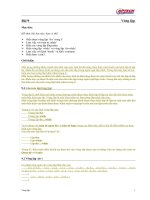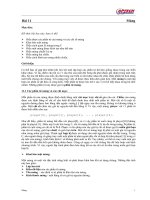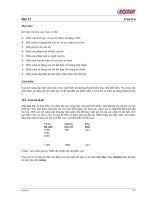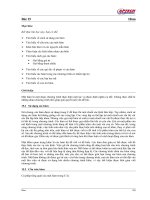Computer concept 2018 module08
Bạn đang xem bản rút gọn của tài liệu. Xem và tải ngay bản đầy đủ của tài liệu tại đây (3.26 MB, 107 trang )
Computer Concepts 2018
Module 8
The ICT Industry
© 2019 Cengage. All rights reserved.
Module Contents
•
•
•
•
•
Section A: ICT Industry Basics
Section B: The Computer Industry
Section C: The Telecom Industry
Section D: Tech Careers
Section E: ICT Laws and Ethics
© 2019 Cengage. All rights reserved.
Section A: ICT Industry Basics
•
•
•
•
•
•
ICT Core Industries
ICT Goods and Services
Technology Life Cycles
Disruptive Technology
ICT and Productivity
ICT and National Security
© 2019 Cengage. All rights reserved.
Section A: Objectives (1 of 2)
•
•
•
List six core ICT industry components and provide examples of businesses in each
•
•
Give at least three examples of ICT consumer goods and three examples of ICT capital goods
List four reasons why the ICT industry is one of the world’s largest economic sectors
Draw a timeline showing stock market trends for the ICT industry through boom and bust cycles
between 1988 and the present year
Distinguish between outsourcing and offshoring
© 2019 Cengage. All rights reserved.
Section A: Objectives (2 of 2)
•
•
Explain how Moore’s law is related to the declining price of ICT products
•
Summarize the global influence of ICT
•
•
•
Draw diagrams representing the product life cycle, Rogers’ bell curve, and the Gartner Hype
Cycle
Provide at least three examples of disruptive technologies and explain their benefits as well as their
drawbacks
List four of the six national security functions provided by the ICT industry
Explain the connection between cyberwarfare and the Tallinn Manual
© 2019 Cengage. All rights reserved.
ICT Core Industries (1 of 5)
•
As the computer industry expanded beyond number crunching to data storage and decision
support, the IT (Information Technology) industry evolved
•
The ICT industry is a result of that evolution; a convergence between the IT industry and the
telecommunications industry
•
Companies and businesses create jobs, develop products, and offer services that drive the
economy; they are classified into economic sectors according to the types of goods and
services they provide
© 2019 Cengage. All rights reserved.
ICT Core Industries (2 of 5)
•
•
The information industry has three major facets: content, computers, and telecommunications
The focus of Unit 8 is the ICT industry, which is made up of businesses that focus on digital
equipment, software, and communications technologies
© 2019 Cengage. All rights reserved.
ICT Core Industries (3 of 5)
© 2019 Cengage. All rights reserved.
ICT Core Industries (4 of 5)
•
ICT is one of the world’s largest economic sectors; revenues exceed those of the oil and gas
industry and the world’s airlines
© 2019 Cengage. All rights reserved.
ICT Core Industries (5 of 5)
•
•
•
The ICT industry has fueled the economies of many countries and was not as deeply affected as
some sectors of the economy during the 2009 global recession
The so-called dot-com bubble was fueled by a frenzy of online business startups called dot-coms
A dot-com bubble that began in the late 1990s burst with devastating effects on ICT stock values;
a stock market bubble refers to a sharp rise in stock values that is later followed by a sudden
decline
© 2019 Cengage. All rights reserved.
ICT Goods and Services (1 of 5)
•
•
•
In economics, goods are things that can be used or consumed, whereas services are intangible
actions performed for a consumer
ICT goods and services can be distributed locally, nationally, or internationally and are purchased
by individuals and corporations
Consumer goods, such as laptops, are purchased by individuals; capitol goods are raw
materials used by businesses to make consumer goods
© 2019 Cengage. All rights reserved.
ICT Goods and Services (2 of 5)
•
The terms outsourcing and offshoring are often used interchangeably, but they are slightly
different
–
–
Outsourcing is the use of components or labor from outside suppliers
Offshoring relocates business processes, such as manufacturing and customer support, to lowercost locations in other countries
© 2019 Cengage. All rights reserved.
ICT Goods and Services (3 of 5)
•
•
•
Until the 1990s, ICT companies performed all phases of product development in house
Prototyping and mass production moved to Taiwan, then to China
Outsourcing and manufacturing efficiencies contributed to falling prices of ICT goods and services
© 2019 Cengage. All rights reserved.
ICT Goods and Services (4 of 5)
Click to edit Master text styles
© 2019 Cengage. All rights reserved.
ICT Goods and Services (5 of 5)
In 1995, $1,800 purchased a desktop computer
In 2015, $500 paid for a laptop computer with a
with a 33MHz processor, 8MB of RAM, a 200 MB
1.7Ghz processor, 4GB RAM, a 500 GB hard
hard disk, a CD drive, and a bulky CRT monitor
disk, and an integrated 15” screen with a
with a maximum 1024×768 resolution.
maximum 1600×900 resolution.
© 2019 Cengage. All rights reserved.
Technology Life Cycles (1 of 3)
•
The product life cycle (PLC) maps the expected profitability of a product from its inception
to its demise
© 2019 Cengage. All rights reserved.
Technology Life Cycles (2 of 3)
•
To try and track a product’s life cycle, analysts and sociologists devised the following:
–
–
–
Moore’s law – Gordon Moore, co-founder of Intel Corp., predicted that technological innovation
would double the number of transistors in an integrated circuit every two years without raising its cost
Rogers’ bell curve – frequently used to describe patterns in the way consumers adopt technology
products; developed by a team of sociologists including Everett M. Rogers
Gartner Hype Cycle – represents the position of a product during its life cycle of publicity or “hype”;
developed by analysts at Gartner, Inc.
© 2019 Cengage. All rights reserved.
Technology Life Cycles (3 of 3)
© 2019 Cengage. All rights reserved.
Disruptive Technology (1 of 2)
•
•
•
Disruptive technology displaces an existing business process, market, industry, or product
Flat-screen LCD technology replaced CRT displays.
Digital photography replaced film photography, which affects camera manufacturers, film
manufacturers, and photo processing shops.
•
•
Computers with word processors replaced typewriters.
Digital publishing and Web-based access to information have had a devastating effect on
newspapers.
© 2019 Cengage. All rights reserved.
Disruptive Technology (2 of 2)
•
Movies replaced radio as a form of entertainment. Movies were then disrupted by television,
which in turn has been disrupted by download and streaming technology.
•
The telegraph was disrupted by the telephone system, long distance by VolP, and land line
service by cellular service.
•
Smartphones have the potential to replace devices such as MP3 players, portable game
consoles,
point-and-shoot cameras, personal video players, voice recorders, handheld GPS
devices, wristwatches, paper maps, and handheld calculators.
© 2019 Cengage. All rights reserved.
ICT and Productivity (1 of 4)
•
In the context of economics, productivity is a measurement of the amount of output that is
produced per unit of input
© 2019 Cengage. All rights reserved.
ICT and Productivity (2 of 4)
© 2019 Cengage. All rights reserved.
ICT and Productivity (3 of 4)
•
The World Economic Forum produces an annual report on the global influence of the ICT
industry and identifies how well countries leverage ICT technologies
© 2019 Cengage. All rights reserved.
ICT and Productivity (4 of 4)
•
Economists use indicators, such as GDP (gross domestic product), to measure the total output of
a nation
•
Between 2011 and 2013 digitization boosted world economic output by US$193 billion and
created 6 million jobs during that period
•
These factors are a compelling argument for national investment in digital technologies
© 2019 Cengage. All rights reserved.
ICT and National Security (1 of 4)
•
•
•
Programs of surveillance, espionage, and sabotage are carried out today using cyberwarfare
hacking tools
The ICT industry plays a major role in national security for countries throughout the world
Infiltrating and disabling computers storing sensitive corporate, government, or military data could
create chaos and temporarily weaken military defenses
© 2019 Cengage. All rights reserved.









